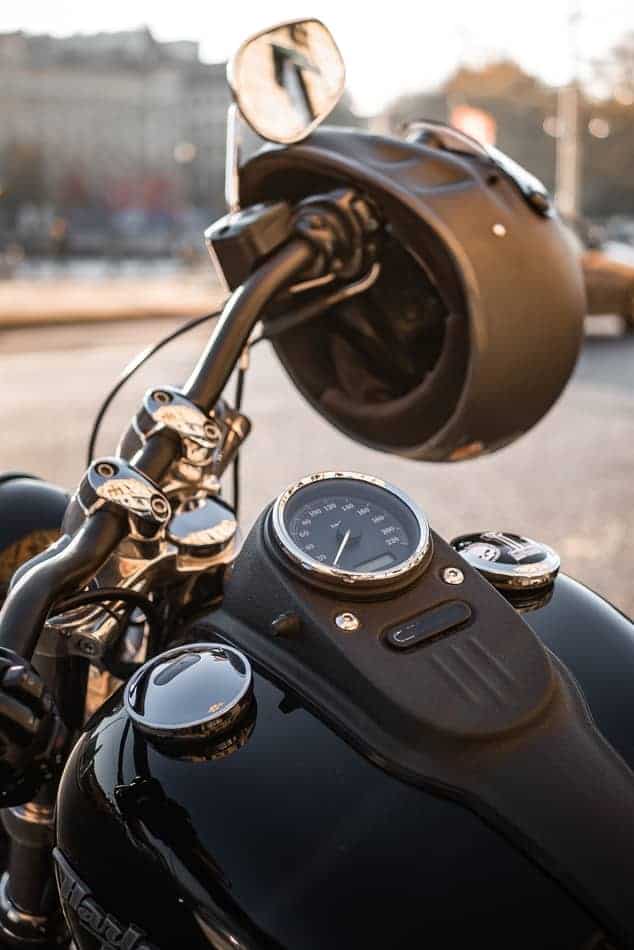
Whether you’re a seasoned motorcycle rider or new to the game, we can all agree that having trouble starting up a motorcycle is one frustrating gig.
Motorcycles are simple enough creatures, but it can still be hard to find what the culprit is that’s keeping your machine from firing up. I’ve been there many times myself. I’ve owned over 13 motorcycles and went through this process with every single one of them.
Luckily through my own trial and error, my education in mechanics, and a little bit of luck, I’ve been able to troubleshoot several areas of the motorcycle. Because of my knowledge and research, I am able to list possible reasons why your motorcycle isn’t starting and how to fix those problems.
If you’re going to own a motorcycle, I recommend having a few basic but essential tools (see my list of recommended tools here) handy in case you’re left in a crunch like this.
Dead Battery
Symptoms of a dead battery: this is the easiest problem to diagnose and is probably the most common reason why a motorcycle doesn’t start.
Depending on how low your battery is, if there is some voltage left you may be able to turn the key as well as turn on your blinker, but turning it over is slow and sluggish. If your battery is completely dead, you motorcycle will not make any noise at all when you try to start it.
How a motorcycle battery dies: If a motorcycle battery is not used and just sits, it will lose it’s capacity to power your motorcycle.
There is also a phenomenon called parasitic drain. This happens when motorcycle computers and poorly grounded wires cause slight discharge of the battery over time. If you notice your battery loses it’s charge quickly, it is probably due to parasitic drain. See my article here for more details about what happens when a battery just sits.
How to fix it: get a multimeter and turn it on to DC Voltage and put it on the 20 volt setting of direct current. Now put the separate leads on the two battery posts (if you’re reading a negative number, that just means you need to switch the leads to the other battery post).
If the reading says anything close to or slightly below 12 volts, charge your battery and try starting your motorcycle again. If it has a really low number, such as 9 volts or below, then you battery is pretty much toast and you’ll need to purchase a new one.
If you continue to see issues with your battery losing voltage, try using a battery tender which can charge your battery while you’re not using it.
Dirty Carburetor
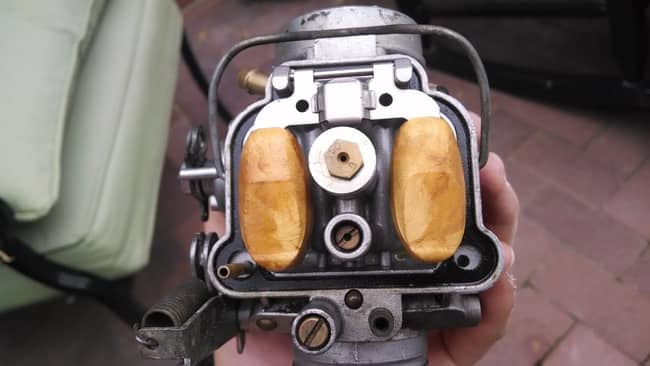
Symptoms of a dirty carburetor: there are a ways to tell if a dirty or malfunctioning carburetor is your problem. If you have an electric starter, take your air intake off, push the starter and spray starter fluid straight into your carburetor. If it starts and revs up for a few seconds then that means your have a dirty carburetor.
How the carburetor gets dirty: Deposits and dirt can build up in your fuel system. As time passes, the build up increases and will easily be able to block fuel passage ways, especially the jets in the carburetor because they are so small. Not using a fuel filter will quickly cause a dirty carburetor.
How to fix it: you’ll need to thoroughly clean your carbs. To do this, you’ll have to take off the air intake then detach the carburetor from your motorcycle engine. Be sure to take pictures before you disassemble so you remember how to put it back together. Label parts using some tape if you need to.
You’ll need to take some of the carburetor apart and purchase a few new gaskets for reassembling. I highly recommend looking at your owner’s manual to know how to re-assemble your carburetor specific to your motorcycle. If you don’t have access to your owner’s manual, check out emanualonline.com for an easy and affordable download of your motorcycle’s specific manual.
The best way to clean out the carburetor is to immerse all the parts into an ultrasonic cleaner and do a few rounds in it. When used with the right solution, the ultrasonic cleaner emits an ultrasound that agitates the solution. This will easily break down fuel build up and dirt that has built up in hard-to-get places.
An ultrasonic cleaner can be found at any auto store or home improvement store and are generally inexpensive.
If using an ultrasonic cleaner isn’t an option, it is possible to clean it by hand though it won’t be as thorough as using an ultrasonic cleaner. You can soak it in hot soapy water then rinse it. Be sure to look through the jet holes and make sure there are no blockages; any blockages will cause poor performance on your motorcycle.
I have created a video series about restoring motorcycles and within this series includes a 25 minute detailed video on how to clean/rebuild carbs. This series also includes other hard-to-tackle components such as body work and electrical. I give dozens of tips and tricks that you won’t find anywhere else online. Click here for more information if you’re interested in viewing multiple videos that will help fix up your bike or if you’re interested in completely building your dream motorcycle!
Blown Fuses
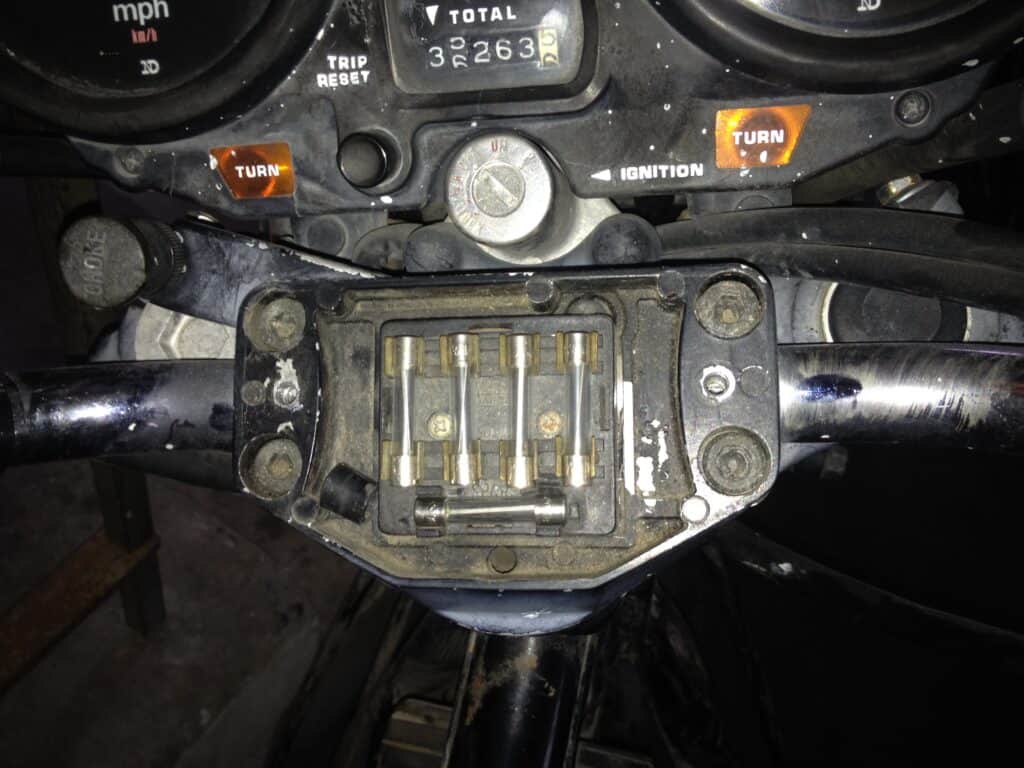
Symptoms of blown fuses: The motorcycle will sound completely normal when you try to start it, but it will spin forever yielding no results.
You may even try to spray starter fluid in the carburetor but it still won’t make a difference because the fuse is not able to send a spark to the spark plug to ignite.
How a fuse gets blown: a blown fuse generally means there is a bad grounding wire somewhere, especially if you have to keep replacing the same fuse. Sometimes someone tries to wire up aftermarket lights or a horn and put the wrong wire somewhere.
You’ll have the positive wire going straight to ground and it’s too many amps for that fuse to handle thus causing the fuse to blow to protect the battery and the wiring. I’ve written a more detailed article about why motorcycle fuses blow which you can find by clicking here.
How to fix it: There is only one fuse that can affect the starting of a motorcycle. Every motorcycle usually has a main fuse which is between 30 to 50 amps (occasionally some bikes will have 20 amps). It is usually located off of the positive battery wire. Sometimes it’s an inline fuse and other times it’s a regular block fuse.
Check the main fuse and see if it’s blown. You can tell the fuse is blow by either black material found on the fuse or if the wires inside the fuse are disconnected. Replace the fuse if necessary. Any auto parts store will be able to identify the right fuse you need.
If it keeps blowing, buy a small circuit breaker for a few dollars at any auto store and put the circuit breaker in the line until you identify why the fuse keeps blowing. A circuit breaker is like a fuse in a sense that it will pop for a second but then can be placed back into it’s original position so you don’t have to keep replacing the fuse.
You’ll need to figure out which wire is poorly grounded. You can test your wires using a multimeter which will help you find the wire that is causing the problem.
Too Cold
Symptoms that your motorcycle is too cold: This is only applicable to motorcycles that have a carburetor and does not usually affect motorcycles that have a fuel injection system. Your motorcycle will sound like it’s attempting to start, but the turning sounds will probably sound a little slower than normal
How cold temperatures keep you from starting your motorcycle: obviously you’ll be able to calibrate this because of the temperature outside. The gasoline inside your motorcycle doesn’t entirely evaporate when it is mixed with air during cold temperatures and therefore combustion sometimes doesn’t occur correctly.
Sometimes there is ice build up within the carburetor, making it impossible for fuel and air mixture to get through some of its parts. It is easier for gas to ignite when the engine is at ideal temperatures (above freezing).
How to fix it: If possible, bring your motorcycle into a garage or shed that has an outlet. You’ll need to plug in a space heater and blow it directly on to your engine and carburetor for at least 20 minutes. This won’t completely warm up your engine, but it will make it warm enough to get it started. I have used this method hundreds of times and it has worked great. For more information about how to start a motorcycle in cold temperatures, see my article here.
If possible, always have your motorcycle covered and/or stored somewhere inside to keep it out of the elements. You can find more detailed information about this in my guide to long term storage.
Clogged Injector
Symptoms of a clogged injector: Your motorcycle will attempt to turn over normally when you try to start it but there won’t be any combustion. If you know it’s sparking correctly and that there is gas in the tank but it has been sitting for a while, your culprit is probably a clogged fuel injector.
You can also manually inspect your fuel injectors. If they look dirty and clogged, that means they need to be cleaned or replaced.
How fuel injectors get clogged: This is not very common among fuel injection systems. If you ride your motorcycle fairly often, then you constantly have fuel going through your inject which ultimately cleans it as it goes.
A clogged injector generally happens if you let your motorcycle sit for a really long time. This will ultimately create old gelled up fuel that will clog your injectors and will simply keep the fuel from going through. See what else happens to your motorcycle when you let it sit by reading my other article here.
How to fix it: There are ways to clean your fuel injectors including using a solution specifically made for this purpose; there’s even a tool made to clean fuel injectors. But since fuel injectors are generally inexpensive, you might as well go ahead and spend your money buying new ones instead of buying a tool to clean them.
Bad Spark Plugs
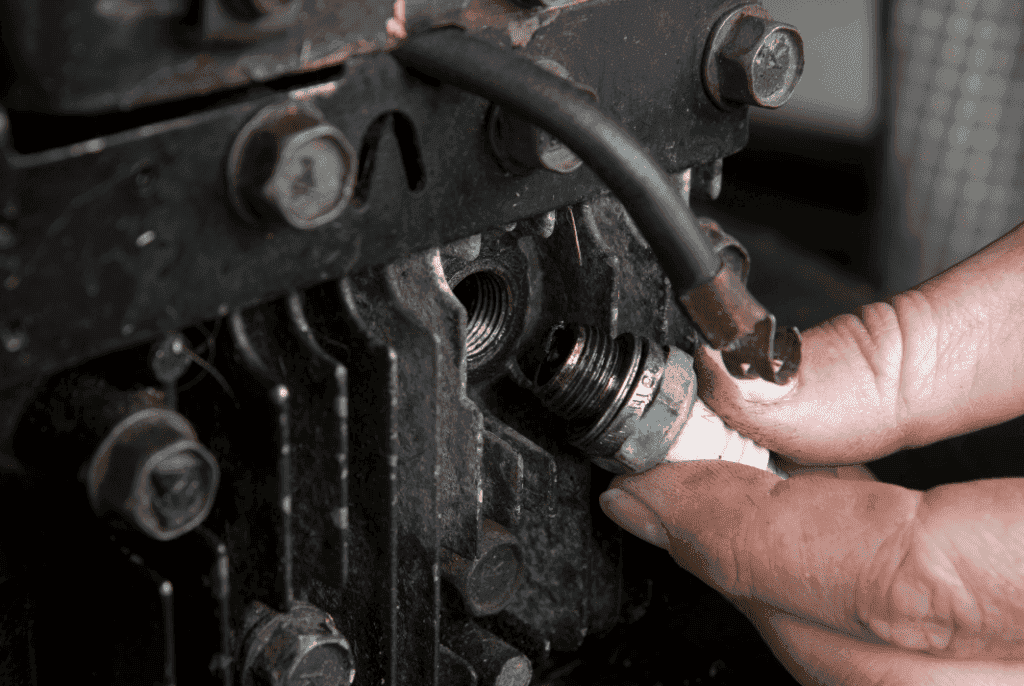
Symptoms of bad spark plugs: When a spark plug is about to give out, the motorcycle will run poorly, sound louder than normal, and almost seem “gutless.” Eventually when a spark plug has gone completely out, your motorcycle will attempt to turn over but simply won’t fire up.
Also, if you have no idea when they were changed last, that might be a good indication that they’re spent.
How spark plugs stop working: a spark plug can go bad a few different ways. First, it’s possible for the ceramic coating to get cracked. When a cracked spark plug is installed, the spark will find the path of least resistance through the crack and ground out to your engine block instead of going all the way down to the end of the spark plug and jumping across the gap like it’s supposed to.
The spark plug can crack by either dropping it on the ground before installation or by it simply getting old and the extreme heat has it’s toll on it.
Second, a spark plug can go bad by fowling. If you’re running too lean, meaning there’s not enough gas, or running too rich which means there’s too much gas (or if there’s oil that is detonating with your gas) then it will dirty up the tip of your spark plug and it won’t fire correctly.
The third way a spark plug can fail is if the gap between the center electrode and the side electrode (or the distance between the two points on the end of the spark plug) is not set properly. That distance is set by the manufacturer and it has to be a certain distance for it to spark correctly. If it’s too far or too close then it won’t spark right.
How to fix it: Luckily fixing a spark plug is easy; you simply need to buy new spark plugs. Spark plugs are usually only a few dollars each and can be found at any auto store. If you need to replace a spark plug, make sure you replace all the other ones as well even if they don’t need it. This will make your motorcycle run much more smoothly.
Bad Starter
Symptoms of a bad starter: This is only applicable if you have an electric starter. A bad started can make several strange sounds. One noise would be a clicking sound. Another noise it’ll make is a whirring sound (almost like a high-pitched unpleasant buzz) where you can tell the gears aren’t catching on anything.
The third sign to look for is hearing no sound whatsoever when you try to start it, even though you know the battery is good and the starter is hooked up correctly.
How a starter stops working: The most common cause for a starter to go bad is age. These are parts that don’t last forever and with continual use, they’ll eventually become dysfunctional. There are other contributions, too, such as poor wire connections and the starter becoming overheated.
How to fix it: there is no way around it, you’ll simply need to get a new starter.
Bad Ignition Coil
Symptoms of a bad ignition coil: A bad ignition coil will cause your motorcycle to have poor spark circulation. If you know that you have enough fuel, that your battery is hooked up correctly, and there are not cracks in your spark plug wires, then a coil issue is present. Poor idling and stalling will lead up to this problem.
Your motorcycle may turn over but will not stay on and will stall out. Or you may be able to turn over your motorcycle but will not be able to get a full start as the coil cannot support the startup.
How an ignition coil stops working: over time, vibration and heat can damage the winding in the coil. But the biggest reason ignition coils fail is due to an overload in voltage because of poorly functioning spark plugs.
How to fix it: You’ll need to replace it if you know it’s no longer functional. Ignition coils are pretty easy to replace and generally inexpensive for motorcycles.
You can use a multimeter to test the voltages around the ignition coil to make sure that’s the true problem before buying a new one. You can learn more about motorcycle ignition coils by reading our other article here.
Cracked Spark Plug Wires
Symptoms of cracked spark plug wires: though the symptoms of a cracked spark plug wire are similar to all the other problems listed in this article, there is on tell-tale sign that your problem is a spark plug wire.
All you need to do is a visual inspection. Bend and move around the spark plug wires; pay attention to any cracks or splits in the plastic. Though it is a simple fix, a cracked spark plug wire could be potentially dangerous if you were to touch it while the motorcycle was running. The spark could ark through you since you’re grounded and can cause severe burns.
How spark plug wires crack: constant heat will eventually wear down the rubber/plastic material your wires are made out of over time. Other extreme weather conditions will speed up this process.
How to fix it: all you need to do is simply replace the spark plug wire. If you notice one wire that’s becoming brittle, it’s a good idea to replace all the other spark plug wires while you’re at it because chances are the rest will crack soon too.
No Air Flow
Symptoms of no air flow: again, you may not have any issues turning it over but may have issues getting your motorcycle to stay on. Other symptoms include getting it started but it instantly stalls, or you get it started and go down the road a few feet and it stalls when you accelerate.
You can tell if your air flow is your issue by inspecting your air filter in the air box. You can temporarily remove your air box or pod filters (if you’re not in a dusty environment) and again try to start up your bike. If your motorcycle starts up then you know your issue is the air flow. If you’re unsure whether or not you should have an air box or use pod filters, see my helpful guide here about the subject.
How air is obstructed: this is usually caused by a dirty air filter that hasn’t been cleaned or replaced in a while or by clogged pod filters (though pod filters don’t usually have a problem with obstructing air).
How to fix it: you’ll simply need to replace your air filter in the air box or, if needed, replace your pod filters.
Timing Is Off
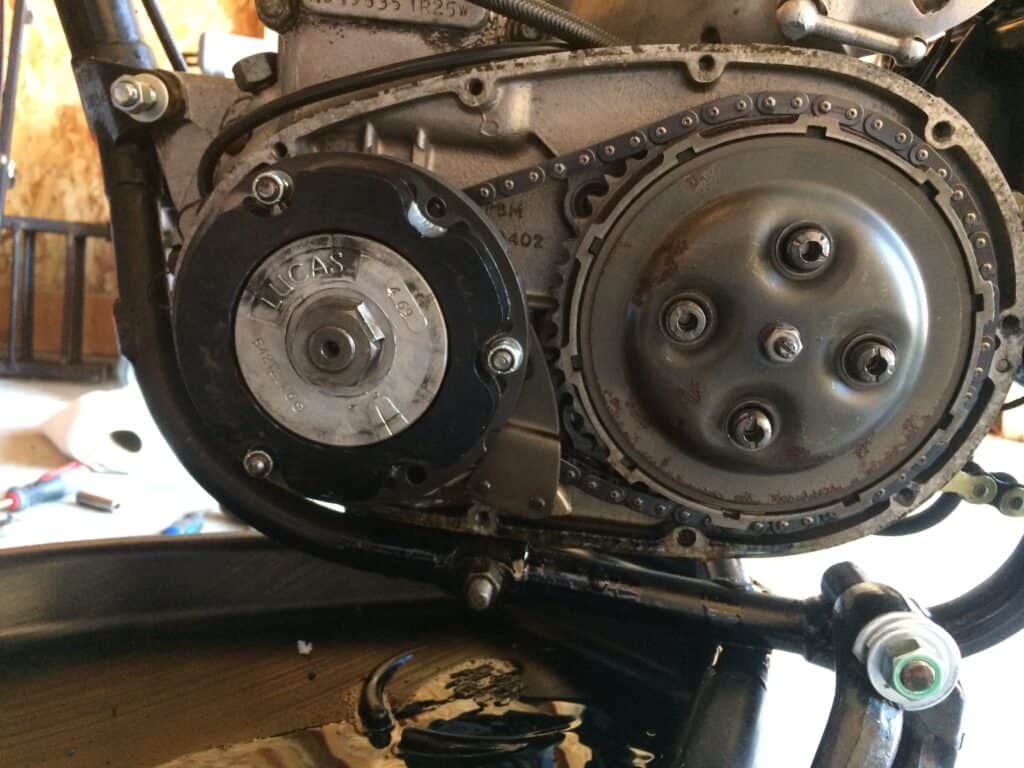
Symptoms that the timing is off: this is most likely not your problem especially if your motorcycle has been previously running okay, but it’s definitely worth mentioning.
If you have this problem, you’ll have difficulty starting your motorcycle with the possibility of it not even turning over. When you attempt to start it, you may hear a ticking sound. You may also be able to get it started and it may backfire then stall. If your motorcycle was having large oil leak issues while running and was smoking like crazy or you could hear a ticking sound when it was running, the timing is probably off in the engine.
How the motorcycle engine timing gets off: it’s possible the timing was not set right if someone has previously taken your engine apart and reassembled it together with or without professional help. The electronic control module could also be very old and may cause your timing to be off.
How to fix it: to know if bad timing is the motorcycle’s issue, you’ll need to remove one of the crankcase covers where you’ll see a timing mark on the stator. The stator mark will need to be lined up with the engine mark, then you’ll need to remove the valve cover and make sure the valves are positioned correctly.
Every motorcycle’s process of timing is different from each other. If you’re a beginner, do not attempt to diagnose and fix this yourself. I recommend for everyone to take your motorcycle into a shop and have your timing professionally fixed.
Seized Engine
Symptoms of a seized engine: If you have an electric starter, your engine will not even turn over if it’s seized. Your starter will make a brief clicking noise then make a humming sound. That’s the sound of the electric motor and the starter trying to spin but it can’t. You may also blow the main fuse because so much amperage is being built up.
If you have a kickstarter, putting it into neutral and not being able to kick start it (meaning you can’t move the kick starter at all) could mean your engine is seized or you have a faulty transmission.
How a motorcycle engine becomes seized: The first and most common reason a motorcycle engine seizes is because of the lack of lubrication. The second reason is due to old or dirty oil. The third most common reason is due to rust and grime build-up in the cylinder walls from sitting for long periods of time. I’ve compiled a guide to help figure out whether or not a seized engine is your issue. You can find that by clicking here.
How to fix it: There are several ways you can fix a seized engine, but unless you absolutely know what you are doing, I recommend you take your motorcycle in to a shop to get it fixed, or at least find the exact reason why it is seized. Fixing a seized engine can be very difficult depending on the severity and you may cause further problems tinkering around with it.
In The Wrong Gear
Symptoms that you’re in the wrong gear: this mostly applies to kick starter motorcycles. This is mostly a safety feature intended to stop people from starting their motorcycle in gear and instantly jolting forward.
Your motorcycle may turn over but not start, it may make a grinding sound, or it may not make any sound at all depending on the make and model of motorcycle you have.
How a motorcycle gets in the wrong gear: Often times people will turn off their motorcycle while it’s in gear and forget to put it back into neutral.
How to fix it: put your motorcycle into neutral and try starting it again.
Related Questions
What are the easiest types of motorcycles to restore? Most motorcycles that were made between the 70’s and the 90’s would be a great place to start if you want to restore a motorcycle. Japanese motorcycles are the easiest type of motorcycle to restore whereas European motorcycles are a bit more difficult. For more info, see my article here.
How difficult is it repairing a motorcycle compared to repairing a car? Motorcycles are a lot more simple to repair compared to cars. However, motorcycles and cars share the same basic systems. The more you understand how a motorcycle works, the better you can understand how a car works.
